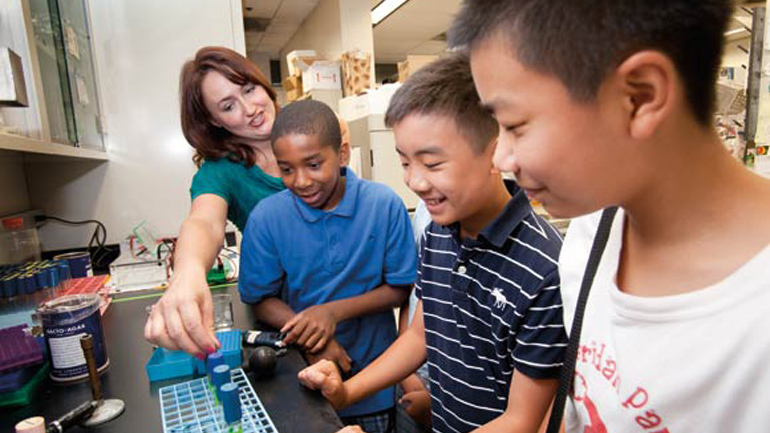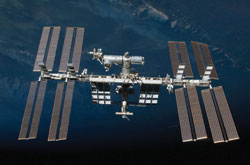
Photo: Michael Goss
A popular character from the Li’l Abner syndicated comic strip was the “Shmoo,” a blob-like, bowling-pin-shaped creature.
Improbable as it may seem, the Shmoo is extending a gesture of celestial goodwill on behalf of a group of Chicago Public Schools sixth-grade students.
They are aiming for the stars in a biology experiment designed to detect the presence or absence of real-life shmoos—polarized growth by yeast cells—in a microgravity environment aboard the International Space Station (ISS). The two-month-long experiment was flown to the station in September on the first operational flight of the SpaceX Dragon commercial spacecraft.
The students, from Skinner West Classical, Fine Arts and Technology School on Chicago’s West Side, were selected for the opportunity through the Student Spaceflight Experiments Program (SSEP). Their laboratory science teacher, Kori Milroy (M.A.S. SED ’11), learned about the program while she was a graduate student at IIT and successfully led a group of fifth-grade Skinner students in their efforts to send an experiment about goldfish development to space last year.
The sixth-graders’ 2012 proposal—“Shmooing Around in Space”—was one of more than 1,100 finalist entries from a nine-state region. A team of scientists, engineers, and science educators from across the United States selected the proposal as among 11 experiments to go to space.
David Stone, a yeast biologist at the University of Illinois at Chicago, met with the six students who crafted the proposal over the spring and summer. He demonstrated how normal yeast shmoos form in response to pheromonal secretion, and practiced group skills for setting up the space experiment and loading the yeast into the NASA apparatus—a Teflon outer tube with two inner glass tubes. In the experiment, an astronaut breaks one of the glass tubes mixing dormant yeast cells with a medium containing the pheromone, while leaving the cells in the other tube unmixed with the pheromone as a control.
“When students come to a real lab to work with a real scientist doing a real experiment, there is no substitute for the experience; it comes to life for them,” says Stone. “Kids are extremely curious about the natural world. We have to nourish that curiosity and show them how real science works.”
IIT Professor Christopher White, chair of the Department of Physics, served as a local judge and, according to Milroy, is one of two influential teachers who stoked her passion for making science come alive for young students.

“The U.S. economy and quality of life that we enjoy is dependent on high-quality STEM education. It’s vital that we get our kids excited about science and technology, and find ways to keep them excited throughout their lives,” says White. “What Kori is doing is amazing, and her dedication to her students inspires me to do the same for mine.”
Milroy, a mother of two preschoolers, says what she wants for her children is what she is trying to impress upon her Skinner students.
“I want them to grow up with the power of being able to answer their own questions,” she says. “I love the fact that their ability to view science as a process changes their way of thinking. It gives them a new way of looking at the world, perhaps answering questions that have never before been answered.”
Sixth-grader Josh Tabuena says he “really likes science because it’s interesting to know more about the world around you,” while fellow shmoo-mate Stone Chen recognizes the reach of science.
“Lots of different jobs refer to science—math is also a part of everything, just like science is,” explains Chen. “I would like science to be a standing structure in my life.”
The students are anticipating the outcome of their efforts, when a Russian Soyuz spacecraft will bring their yeast experiment back to Earth for analysis, landing in Kazakhstan in November. No matter what the Skinner students discover, their experience will remain with them throughout their future science education.
“We ought to be able to immerse upper-elementary school students in every facet of real research, and stand back and be amazed; that’s exactly what we’re seeing,” says Jeff Goldstein, director of the National Center for Earth and Space Science Education and SSEP creator. “What we would like are students who are prepared to come in as explorers, critical thinkers, and individuals who are at ease integrating across disciplines so that universities have that kind of skill set in their students as soon as they walk through the door.”
More Online
National Center for Earth and Space Science Education: http://ncesse.org
Student Spaceflight Experiments Program: http://ssep.ncesse.org